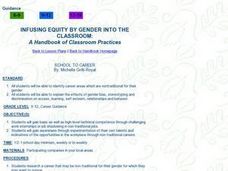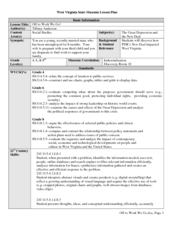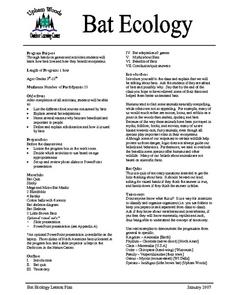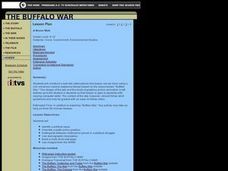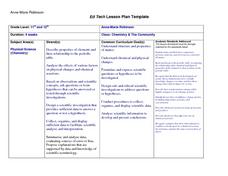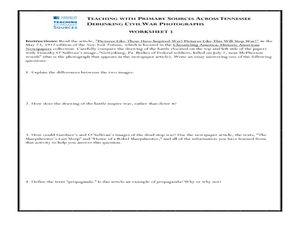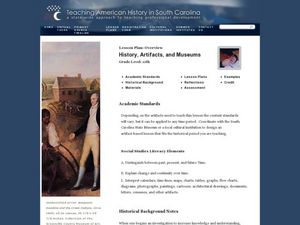Curated OER
Gender Equity in the Classroom and the Workplace
Young scholars research careers non-traditional to their genders. They job shadow at cooperating businesses and investigate gender bias, stereotyping, and discrimination.
Curated OER
Off to Work We Go!
Students create a book about The Great Depression in West Virginia. In this West Virginia history lesson, students visit the West Virginia State Museum, answer questions about West Virginia history, and create a book entitled...
University of Pennsylvania
Using Comic Strips to Teach Multiple Perspectives
Scholars view comics from two different perspectives; one paints the Alfred Dreyfus as innocent, while the other portrays the exact opposite. They solve the mystery of what happened by analyzing the source, working in groups, and...
Curated OER
Luxury Hotel
Give the most important people watching the Olympics a beautiful place to stay! Learners create a luxury hotel for the games using AppleWorks, fractions, and their knowledge of perimeter and area. The math activity includes resource...
Anti-Defamation League
Identity-Based Bullying
What is identity? What is bullying? What is identity-based bullying? After discussing these questions as a class, pupils engage in partner discussions before participating in a small group activity to act out bullying scenarios. Then,...
Curated OER
Maps and the Pictures in Our Heads
Geographers of all ages examine different types of maps. They draw maps of their environment, utilizing both three-dimensional and picture maps. They interpret map information, noting how it can sometimes be misleading. Some good...
Curated OER
Interactive Duty
Students consider the role of multimedia news features. They analyze the New York Times coverage of the president's State of the Union address.
Curated OER
“And Still I Rise” Proud Black Women
Students examine the experiences of African American women. In this poetry instructional activity, students use their literary analysis skills to compare the poetry of Maya Angelou to rap music performed by Queen Latifah and Lauryn Hill.
Curated OER
Using Primary Source Documents in the Classroom
Learners use primary documents to explore the past. They consider the source of the documents and identify and biases that the author may have held. They identify any questions about the historical event that may remain after reading the...
Curated OER
A Free and Open Press: Evaluating the Media
Students compare and critically evaluate the different media as sources of news, develop criteria for defining "news", experience the editorial process of selecting news stories and detect bias in news reporting.
Curated OER
Bat Ecology
Students, through hands on games and activities, discover how bats live and how bats benefit ecosystems. They play a game designed to show them how echolocation works and another to show how mother bats locate their young through their...
Curated OER
The Real Monopoly: America's Racial Wealth Divide
Students explore America's racial wealth divide. In this Teaching Tolerance lesson, students play a "rigger" version of the game Monopoly and reflect on the game and economic injustice in the United States.
Curated OER
Health and Food Safety
Learners discuss ways to keep healthy, and examine factors that influence health, including media. They then participate in mock public meeting on genetically modified foods in order to explore importance of governmental decisions in...
Curated OER
A Bison Web
High schoolers view a documentary on the treatment of the buffalo. In groups, they create a website using ideas and solutions they developed. They must include graphics or animation and a multi-level webpage. They share their pages...
Curated OER
Chemistry & The Community
Students complete a Webquest which investigates the chemistry in items such as shampoo. They research the Internet, perform a lab experiment, and write a scientific lab report with their findings. Upon completion of the activities, the...
Curated OER
The Great Depression in North Carolina: Experiences of the People
Students explore the Great Depression. In this research skills instructional activity, students interpret historical evidence presented in primary and secondary sources. Students write their own WPA interviews after they...
Curated OER
Teaching with Primary Sources Across Tennessee: Debunking Civil War Photographs
High schoolers analyze photographs and texts using primary source analysis. In this primary source lesson students determine whether the photographs and text are truthful.
Curated OER
The Atomic Bomb Dilemma
Learners examine consequences of using atomic bomb in light of resulting peace, distinguish between fact and opinion and analyze sources to recognize bias and points of view, and assume role of reporter, critic, cabinet member, or...
Curated OER
Our Unfinished Work
Students investigate the racism elements after the election of President Barack Obama. In this racism lesson, students read a recent article about 'post-racial' society. Students compile a list of achieving a post-racial society and...
Curated OER
Examining newspapers
Students compare and contrast tabloid and broadsheet papers. In this journalism lesson, students examine how techniques and form differs from one type of publication to the other. The culminating activity is for students to take what...
Curated OER
History, Artifacts, and Museums
Eleventh graders interpret historical evidence presented in primary and secondary resources. In this historical artifacts lesson, 11th graders select and research historical topics that require them to interpret calendars, timelines,...
Curated OER
Bias in Statistics
Students work to develop surveys and collect data. They display the data using circle graphs, histograms, box and whisker plots, and scatter plots. Students use multimedia tools to develop a visual presentation to display their data.
National Endowment for the Humanities
Faulkner's As I Lay Dying: Burying Addie's Voice
Students explore the use of voice and title in William Faulkner's, "As I Lay Dying". They identify and discuss the use of image, symbols and narrative voice in the story.
Stanford University
Japanese American Incarceration
Using documents, such as reports from government sources and civil rights activists, budding historians explore the justification for forcing hundreds of thousands of Japanese-Americans to leave their lives and re-evaluate that tragic...


